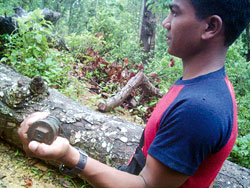|
|
Landmines and improvised explosive devices are notoriously prevalent in Nepal. Used primarily as strategic obstacles and tripwires, they continue to dot the countryside as remnants of war. Since the 2005 ceasefire alone, there have been over 350 casualties within 58 of Nepal's 75 districts.
Even more disturbing is that over half of today's victims are children, a higher percentage than anywhere else in the world. Mines kill indiscriminately, and can lie active for over 50 years as a cruel reminder of the elusiveness of true peace. Throughout Nepal, tens of thousands of these devices still wait to claim new victims.
Fortunately, the machinery of hope has begun. Identified as a priority issue in last year's peace agreement, momentum on clearing landmine-affected areas is increasing, and the first team of Nepal Army forces trained by UNMIN-contracted ArmorGroup has already demined several sites.
Most notably, last month's clearing of the 174 mines near the Khimti hydropower plant restored full functional capacity to a valuable local utility. The Maoists and the Nepal Army forces are now willingly providing sensitive military information to assist in mine cleanup efforts.
A lot of the credit goes to anti-mine activist Purna Shobha Chitrakar of the Nepal chapter of the International Campaign to Ban Landmines (NCBL). Chitrakar has helped spread public awareness of the landmine issue among Nepali politicians despite years of apathy. Landmines and unexploded ordnance are now viewed as legitimate humanitarian concerns and a legacy of the war.
UNICEF and Handicap International are developing and expanding their victim assistance programs. Beneficiaries include those maimed by the 2005 Madi bus attack and orphans of mine victims. The program provides long-term integration solutions through education scholarships for children and resources for mine victims to start businesses. However, limited funding means that only a fraction of victims are assisted. This life-changing scheme can be expanded throughout Nepal if funding is increased.
After initial delays demining activities are now progressing through Maoist, Nepal Army, and UN joint activities. Nepal Army Brigadier General and head of mine operations Lok Thapa, UNMIN senior mine action adviser Grant Milthorpe and the Maoist leadership deserve recognition. Farms and strategic and military bases are being demined, one of the few directives of the peace agreement that are actually being implemented.
Now, Nepal needs to ratify the Ottawa Treaty and join the156 states that have already signed it pledging to eliminate landmines and improvised explosive devices (IEDs) from combat use. Although all parties in Nepal have agreed in principle to the treaty, foot dragging in the interim assembly has delayed action. Mines and IEDs can comprise a key component of military strategy, but the fact that they do not distinguish between civilians, allies, and enemies illustrates that they have no place in any war fought on behalf of citizens.
Access to mined areas remains a primary hurdle due to military wariness and lack of infrastructure. Further, mapping of existing terrain is either incomplete (Nepal Army sites), or nonexistent (Maoist), rendering the true scope of the problem unclear. Also, devices occasionally explode in houses after being collected for their metal value. Although casualties have diminished substantially since 2005, all current deaths and injuries now are victim-activated.
While recognising the difficult road ahead, all parties involved should be commended for their efforts thus far to eradicate a monstrous leftover of war. In a time when interim legislatures are adjourned almost as soon as they begin, and partisan political bickering continues, it is easy to overlook real progress. For once, there is enough credit to pass around.
Jason Miklian is a researcher with the International Peace Research Institute, Oslo (PRIO).
jason(at)prio.no



